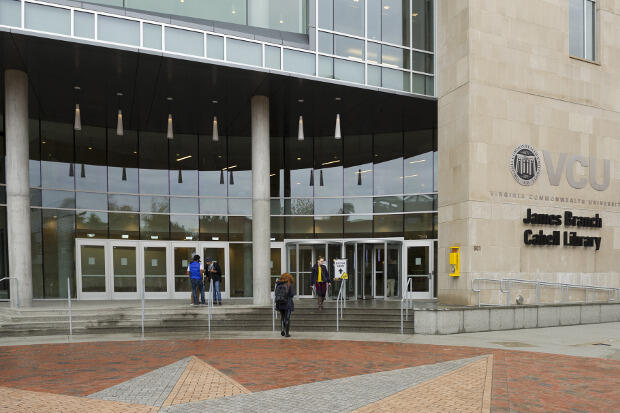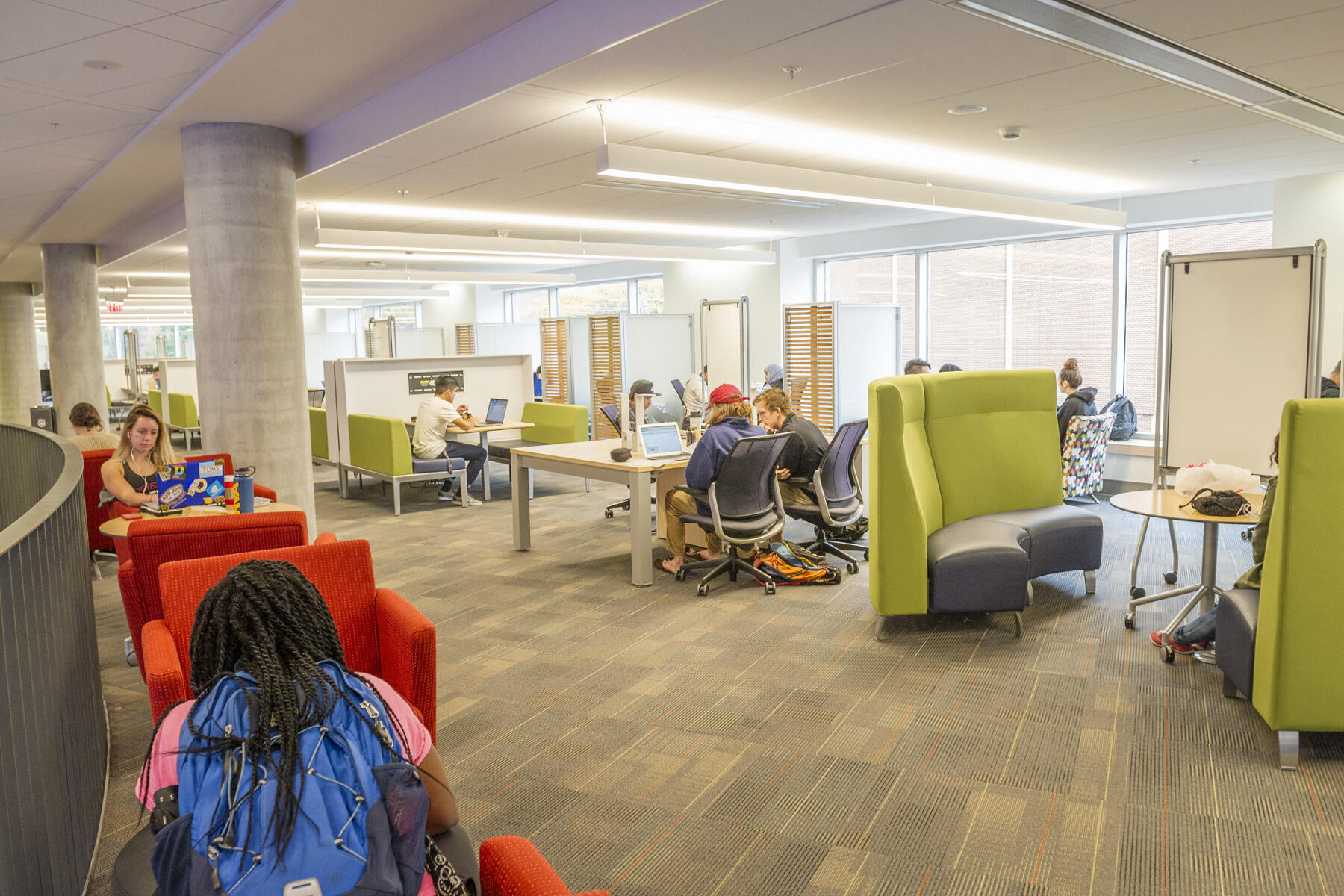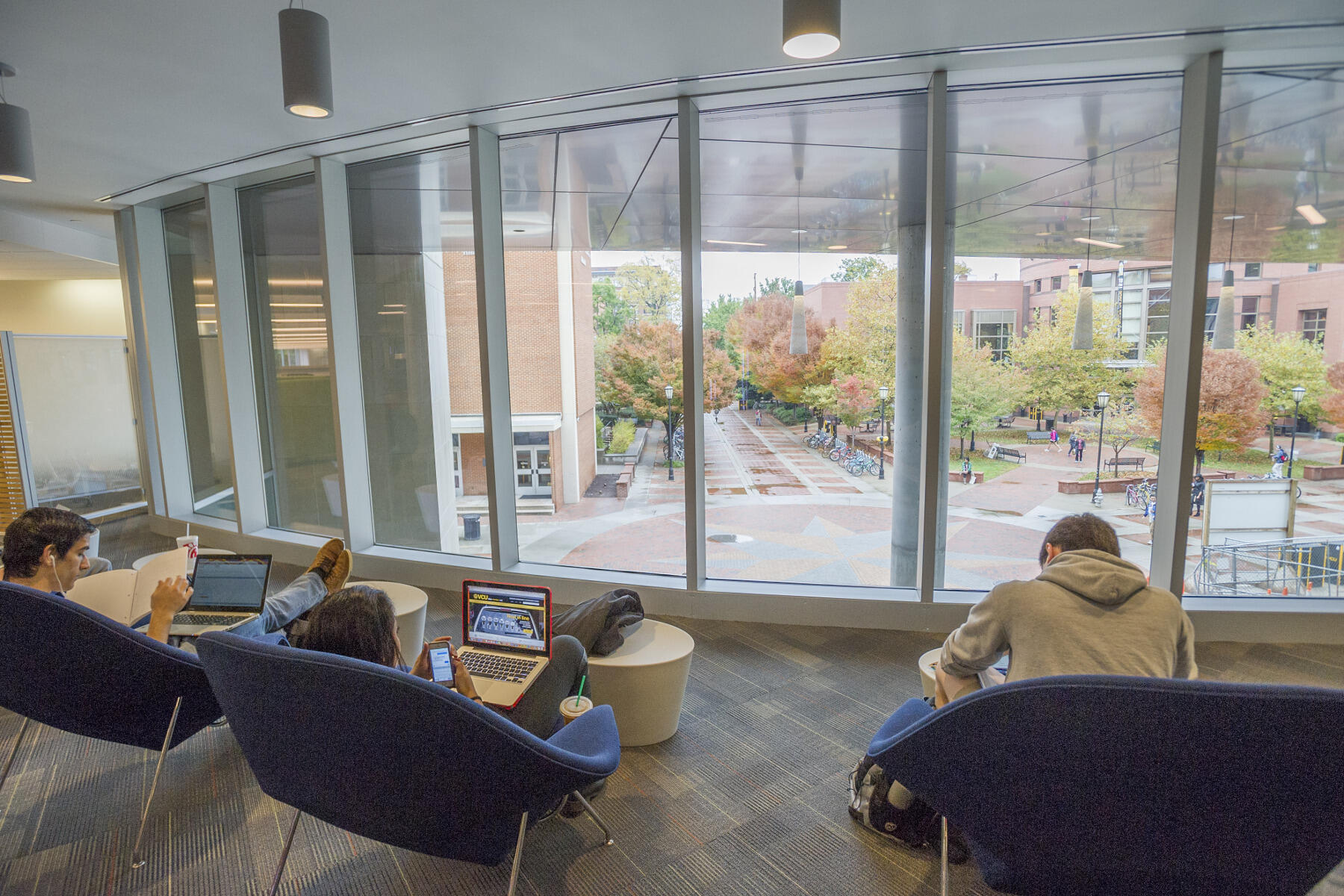
Nov. 2, 2015
$50.8 million expansion, renovation of VCU’s main library is now open
Share this story
Virginia Commonwealth University’s greatly expanded and renovated James Branch Cabell Library is now open, providing VCU’s more than 31,000 students with vastly more space to study, collaborate, discover, create, and conduct research.
The $50.8 million project adds 93,000 square feet of new construction and 63,000 square feet of improvements to the existing library, with 90 percent of the space designed specifically for student use.
“There simply is no great university without a great library,” said University Librarian John Ulmschneider. “I think our new library truly captures the accomplishment, the pride and the optimism that is VCU today.”
There simply is no great university without a great library.
The first two floors of the new library building open to the public today, while final construction of floors three and four is slated for completion in December and those floors will be furnished and open for the spring semester.
A state-of-the-art innovative media studio, which will feature a variety of maker tools and technology, such as 3-D printers and scanners, laser cutters, Arduino boards and robotics, will open early in the spring semester in the new library building’s lower level.
James Branch Cabell Library, which is among the busiest academic libraries in Virginia, was built in 1970 and expanded to its current five floors in 1975. Over the past decade, use of the library has doubled to serve more than 2 million visitors annually.
“The new building is filled with features, innovations and architectural beauty that I think capture and express the immense pride we all have in our university,” Ulmschneider said. “It reflects the maturation of VCU over the past 20 years — a building that almost shouts out to everyone who enters it: VCU has arrived.”
“To have such a building at the very center of academic life at VCU will change the way all of us think about our university,” Ulmschneider continued. “It will communicate to every visitor, every faculty member, every student, day in and day out, the commitment to academic rigor, to research and to learning that distinguishes the nation’s great research universities.”
One of the most important goals of the expansion is to provide much-needed relief for the overcrowding in the existing library. The new library building adds more than 1,000 new seats, many more computers and far more academic work space.
“The library is where students get work done, and the new library will help them do that,” Ulmschneider said.
Unlike yesterday’s library, the new building is not lined with shelves holding millions of books. Cabell Library’s collection of books numbers more than 2 million volumes. However, no new shelves were added to the new areas. The new space embraces a vision for libraries that provides a constellation of spaces, resources — including books, digital materials and technology — and services that facilitate student and faculty success.
“Our new library will meet the diverse needs individuals have for their work, quiet study space for some, group collaboration spaces for others, and everything in between, including gender-neutral, single-user restrooms and two lactation rooms for nursing mothers, while providing access to all of the vast and diverse forms of intellectual expression in the print and digital universe,” Ulmschneider said.
On the first floor, visitors will find the service area, as well as seating and a number of reading tables. And, in the spring, visitors will be greeted by a large white oak bench that will be evocative of the James River, from the Pony Pasture to the Mayo Bridge, designed by Heath Matysek-Snyder, an assistant professor of craft/material studies in the School of the Arts.
The Starbucks on the first floor is being expanded, and is expected to be completed in early spring. The coffee shop, which is not slated to close during construction, will be three times larger than the existing café and will feature two serving lines and a two-story atrium with additional seating and views of Shafer Court.
The second floor is primarily study space, including collaborative spaces and two dedicated library instruction rooms, which will expand the library’s ability to meet the demand by faculty for more classroom space.

On the third floor, there will be a significant amount of quiet study spaces, as well as an event space with seating for 250 to 300 people, and a “reading porch” that will feature outdoor-style furniture, ceiling fans and windows that can be opened. On the north side, a terrace overlooking Shafer Court will allow students to walk outside.
The fourth floor will feature a large silent reading room for all students, and an equally large silent reading space reserved for graduate students and faculty.
The big need — the huge need — was additional study space for students.
“It’s not a building for our collections. We aren’t housing any books. The big need — the huge need — was additional study space for students,” said Jeanne Hammer, associate university librarian for administration and policy development. “We had the least square feet per student of any college or university in the state. And the place [has been] stuffed to the gills. The students need places where they can actually focus on their work.”
A guiding philosophy of the renovation of Cabell and the addition of the new building was to emphasize spaces that are flexible and serve the elastic nature of learning today, rather than the old-school style of libraries that primarily served students working by themselves.
“In the library of 1975, it might have been [characterized by] long tables, reading lamps and the kind of head-down studying, surrounded by books,” said Dennis Clark, associate university librarian for research and learning. “Now it’s very much about people interacting with their course work together. Now it’s very much about sharing information, in a myriad of different ways.”
As part of that philosophy, the new library will do away with the traditional reference desk and replace it with three small consultation pods that will allow for one-on-one conversations with staff.
“We want to be more approachable,” Clark said. “We’ll be less formal, where you have to reach across a desk. Now, it’s about ‘Let’s discover together. Let’s get to the bottom of your research need.’ So we’re getting rid of the desk and we’re moving to be more collaborative, with a low barrier to access.”
VCU Libraries’ Special Collections and Archives has also received a good amount of attention, having been renovated to be a more modern, light-filled space that ensures its collections are more accessible and secure.
“Special Collections and Archives is really growing by leaps and bounds,” Clark said. “Special Collections here in Cabell had been a fast-growing collection for a long while, but just didn’t have a very large footprint. The opportunity here is to expand the space, and put in compact shelving — really high-density shelving — in a space that is secure, has the right kind of climate control and has the right kind of access.”

Overall, Ulmschneider said, the new library represents a gigantic step forward in the scale and scope of what libraries can provide to the community, and allows students to realize the full promise of Cabell Library for their academic work.
“Its innovative features express the creativity we see every day among our faculty and students,” Ulmschneider said. “Its design empowers, facilitates and catalyzes academic work in myriad, powerful ways. And I think its beauty and elegance, the magnificent views it provides of the campus, and its inspiring visual statement at the very center of our campus, will say more about VCU and what it’s become than any words we can find.”
Subscribe to VCU News
Subscribe to VCU News at newsletter.vcu.edu and receive a selection of stories, videos, photos, news clips and event listings in your inbox.










